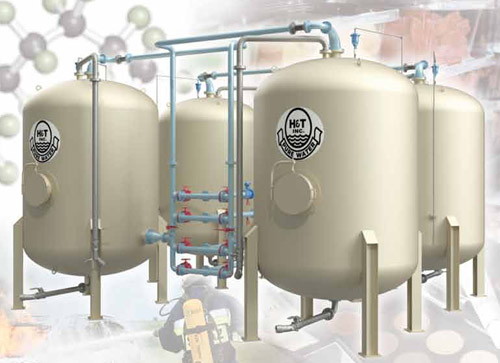Cutting-edge PFAS Therapy Solutions for Safer Water
The raising occurrence of PFAS contamination in water materials requires a critical evaluation of ingenious therapy remedies. Advanced purification innovations and novel chemical therapies present promising opportunities for decreasing these persistent contaminants. In addition, emerging bioremediation techniques offer an even more sustainable strategy to tackling PFAS obstacles. As governing frameworks continue to adjust, comprehending the performance and scalability of these solutions comes to be paramount. What effects do these improvements hold for public health and wellness and ecological reconstruction, and just how can stakeholders successfully implement them in diverse contexts?
Review of PFAS Contamination
PFAS contamination has actually become a considerable ecological and public health issue. Per- and polyfluoroalkyl materials (PFAS) are a group of artificial chemicals recognized for their determination in the atmosphere and body, leading them to be typically described as "for life chemicals." These substances have actually been extensively made use of in different sectors, consisting of firefighting foams, water-repellent materials, and food packaging, mainly as a result of their water- and grease-resistant residential properties.
The extensive use PFAS has actually led to their detection in dirt, water products, and even in the blood of human beings and pets. Research studies have linked PFAS direct exposure to various health concerns, including developmental impacts in babies, body immune system dysfunction, and various forms of cancer cells. In addition, the ecological persistence of these substances complicates their destruction and removal, raising concerns concerning long-lasting ecological influences.
Regulative bodies are progressively executing stringent standards to keep an eye on and decrease PFAS degrees in alcohol consumption water and other ecological mediums. As awareness of PFAS contamination expands, it has actually become necessary for communities and markets to seek efficient treatment services to alleviate exposure and protect public health and wellness.
Advanced Filtering Technologies
As the urgency to attend to PFAS contamination magnifies, advanced filtration innovations have actually emerged as a pivotal part in the removal initiatives targeted at removing these consistent chemicals from water resources. These modern technologies leverage innovative systems to properly target and catch PFAS compounds, which are notoriously resistant to standard treatment techniques.
Among the most promising strategies is the use of granular triggered carbon (GAC), which adsorbs PFAS molecules because of its high area and porous structure. This technique has actually been widely executed in both metropolitan and industrial settings, showing significant reductions in PFAS concentrations. Furthermore, ion exchange materials have actually gained traction, particularly made to precisely bind PFAS ions from water, hence facilitating their removal.
Membrane filtering modern technologies, such as reverse osmosis and nanofiltration, additionally reveal efficacy in PFAS removal by physically dividing pollutants from water - pfas management. These systems can attain high degrees of pureness, making them ideal for alcohol consumption water applications
Chemical Treatment Advancements
Countless chemical therapy technologies are being explored to efficiently resolve PFAS contamination in water supplies. One promising method involves the use of advanced oxidation processes (AOPs), which utilize powerful oxidants such as ozone, hydrogen peroxide, or chlorine dioxide incorporated with UV light to damage down PFAS compounds into much less harmful substances. This method has demonstrated efficacy in research laboratory setups, revealing potential for scalability in real-world applications.
Another innovative strategy is the growth of ion-exchange materials particularly made to target PFAS. These materials can precisely adsorb PFAS compounds from water, enabling their removal throughout treatment processes. Recent innovations have actually improved the efficiency and ability of these resins, making them a positive alternative for water therapy facilities.
In addition, scientists are examining making use of chemical representatives like persulfate and ferrous ions to improve the degradation of PFAS in infected water. discover here These representatives can induce chemical responses that assist in the break down of persistent PFAS substances.
Emerging Bioremediation Strategies
Current developments in chemical treatment developments have actually led the way for discovering bioremediation techniques as a viable option for dealing with PFAS contamination. Bioremediation uses the natural metabolic procedures of bacteria to degrade or change toxins, making it an attractive method for tackling consistent impurities like PFAS.
Emerging strategies in bioremediation consist of the use of genetically crafted microorganisms that can particularly target and damage down PFAS substances. These microbial strains are being established for their boosted degradation abilities, raising the efficiency of the remediation procedure. In addition, researchers are checking out the possibility of plant-assisted bioremediation, where certain plant species might uptake and withdraw PFAS from infected soil and water.
One more promising strategy is the application of bioaugmentation, which includes introducing beneficial microorganisms right into infected atmospheres to increase the degradation of PFAS. This technique can facilitate quicker removal timelines and boost total efficiency.

Governing Frameworks and Criteria
A comprehensive regulative framework is necessary for properly taking care of PFAS contamination and ensuring public health protection. The enhancing recognition of per- and polyfluoroalkyl substances (PFAS) as toxic wastes has triggered different federal and state firms to create criteria that control their visibility in water products. The United State Epa (EPA) has established health advisories and is check functioning towards establishing enforceable limitations for PFAS in drinking water.
State-level policies vary significantly, with some states taking on more stringent standards than those suggested by the EPA. These policies frequently include optimum impurity levels (MCLs) for particular PFAS compounds, surveillance demands, and reporting responsibilities for water utilities. Additionally, arising structures focus on the remediation of infected sites, emphasizing the demand for efficient treatment modern technologies.

Conclusion
To conclude, the development and implementation of innovative PFAS therapy options are crucial for attending to the pervasive problem of water contamination. Advanced filtration technologies, chemical therapies, and emerging bioremediation techniques jointly provide a multifaceted approach to properly lower and break down PFAS levels. As regulatory structures proceed to progress, integrating these innovations will be necessary to safeguard public wellness and restore the honesty of polluted water sources, Our site inevitably contributing to a cleaner and more secure atmosphere.